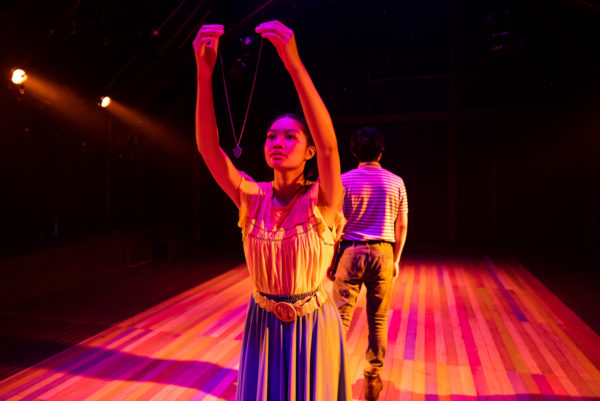The closing scene of Albany Park Theater Project’s “Homecoming” celebrates the power of music in the lives of students, framed through shared memories of a beloved music teacher. As the talented teen ensemble members sang and danced to music ranging from “Ave Maria” to The Beatles and Pharrell Williams, I wondered what each of these students has been through since the company last performed for live audiences in February 2020. Given the countless sorrows and stressors of the past two years, it was incredibly heartwarming to see these young people reunited on stage, pouring themselves into an art form about which they are clearly passionate.
Now in its 25th anniversary season, Albany Park Theater Project (APTP) develops new works based on true stories of immigrants, Chicago teens, people living in poverty and others whose voices lack representation on stage. With guidance from an adult artistic team, an ensemble of teens — primarily people of color from immigrant families — stars in these original productions. APTP shows have garnered critical praise over the years, and several have played downtown at the Goodman Theatre. The company also has a strong focus on social justice and encourages its ensemble members to be civically engaged, as well as providing them with mentorship, tutoring and support to prepare for college.
“Homecoming” is a compilation of scenes from four popular productions spanning the company’s history: “Aquí Estoy” (2003), “Feast” (2010), “Home/Land” (2012) and “Motives for Not Drowning” (2000). It opens with the love story of a young Honduran couple, Mateo (Abraham Roman) and Elena (Beatriz Gigante), depicted through a quietly moving dance with musical accompaniment by ensemble members Joseph Morco and Gabrielle Reyes. When Mateo suffers an injury that ends his soccer career, he makes the painful decision to leave his family and seek work in the United States to support them.
Completing the treacherous journey after four attempts, Mateo starts to work as a day laborer in Chicago, rising early each morning to compete for scarce jobs from exploitative contractors. The choreography in this excerpt from “Aquí Estoy,” directed by Miguel Angel Rodriguez and Devika Ranjan, creatively complements the story. Percussive movements depict the sound of the train that crosses Mexico with Mateo clinging to its roof and the numbingly repetitive motions of his work in construction and demolition. The ensemble chimes in to add details about the dangerous work conditions, economic insecurity and racism they face in these jobs. They defiantly assert that the right to work is a human right.
“Feast” also focuses on the sacrifices that people make to feed their families. The scene presented in “Homecoming” introduces three children whose parents use LINK cards, or food stamp benefits, to buy groceries. Bilingual, 11-year-old Maia (Lesly Aguirre) fills out a LINK application form for her Spanish-speaking mother, precociously lugging out a giant dictionary to look up words such as “citizen” and “mortgage.” Meena (Angeline Guerrero Bautista) dances around the stage with a grocery cart, ecstatically rattling off her favorite foods from Aldi. Mila (Nida Baig) recalls the stigma of using a LINK card at Jewel and vows to make enough money to support her mother someday.
In the excerpt from “Home/Land,” Luca Rivera (Ari Salgado) loses [his] mother to cancer, which she contracted after working for years in a plastics factory. Rivera becomes an activist for Dreamers who entered the country as minors. [He] participates in “Undocumented and Unafraid” rallies in Chicago and lobbies the U.S. Senate to vote on the DREAM Act — all in honor of [his] immigrant mother who never complained of the dangerous conditions at her workplace out of fear that she would lose her job.
“Motives for Not Drowning” highlights the legacy of Mr. Edwards, a music teacher whose positive impact on his students lives on after his untimely death. This music-heavy finale features most of the 21-member ensemble in a blend of poignant moments and pure joy. Among the soloists, the vocals of Gigante and Morco are especially beautiful, with solid work on the piano from Reyes. The scene is a compelling tribute to the importance of the performing arts for young people — both the characters and the actors. It’s impossible not to smile along with the enthusiastic ensemble members as they take their bows.
It’s always a pleasure to see another Chicago theater reopen, but the aptly named “Homecoming” feels like a particularly special event for the Albany Park community. Many audience members seemed to know each other beforehand, and their support for the ensemble was palpable. For those who aren’t local, it’s worth a visit to the Albany Park Theater Project’s picturesque location in Eugene Field Park. Unless you have a heart of stone, these young performers are sure to inspire you.
Now in its 25th anniversary season, Albany Park Theater Project (APTP) develops new works based on true stories of immigrants, Chicago teens, people living in poverty and others whose voices lack representation on stage. With guidance from an adult artistic team, an ensemble of teens — primarily people of color from immigrant families — stars in these original productions. APTP shows have garnered critical praise over the years, and several have played downtown at the Goodman Theatre. The company also has a strong focus on social justice and encourages its ensemble members to be civically engaged, as well as providing them with mentorship, tutoring and support to prepare for college.
“Homecoming” is a compilation of scenes from four popular productions spanning the company’s history: “Aquí Estoy” (2003), “Feast” (2010), “Home/Land” (2012) and “Motives for Not Drowning” (2000). It opens with the love story of a young Honduran couple, Mateo (Abraham Roman) and Elena (Beatriz Gigante), depicted through a quietly moving dance with musical accompaniment by ensemble members Joseph Morco and Gabrielle Reyes. When Mateo suffers an injury that ends his soccer career, he makes the painful decision to leave his family and seek work in the United States to support them.
Completing the treacherous journey after four attempts, Mateo starts to work as a day laborer in Chicago, rising early each morning to compete for scarce jobs from exploitative contractors. The choreography in this excerpt from “Aquí Estoy,” directed by Miguel Angel Rodriguez and Devika Ranjan, creatively complements the story. Percussive movements depict the sound of the train that crosses Mexico with Mateo clinging to its roof and the numbingly repetitive motions of his work in construction and demolition. The ensemble chimes in to add details about the dangerous work conditions, economic insecurity and racism they face in these jobs. They defiantly assert that the right to work is a human right.
“Feast” also focuses on the sacrifices that people make to feed their families. The scene presented in “Homecoming” introduces three children whose parents use LINK cards, or food stamp benefits, to buy groceries. Bilingual, 11-year-old Maia (Lesly Aguirre) fills out a LINK application form for her Spanish-speaking mother, precociously lugging out a giant dictionary to look up words such as “citizen” and “mortgage.” Meena (Angeline Guerrero Bautista) dances around the stage with a grocery cart, ecstatically rattling off her favorite foods from Aldi. Mila (Nida Baig) recalls the stigma of using a LINK card at Jewel and vows to make enough money to support her mother someday.
In the excerpt from “Home/Land,” Luca Rivera (Ari Salgado) loses [his] mother to cancer, which she contracted after working for years in a plastics factory. Rivera becomes an activist for Dreamers who entered the country as minors. [He] participates in “Undocumented and Unafraid” rallies in Chicago and lobbies the U.S. Senate to vote on the DREAM Act — all in honor of [his] immigrant mother who never complained of the dangerous conditions at her workplace out of fear that she would lose her job.
“Motives for Not Drowning” highlights the legacy of Mr. Edwards, a music teacher whose positive impact on his students lives on after his untimely death. This music-heavy finale features most of the 21-member ensemble in a blend of poignant moments and pure joy. Among the soloists, the vocals of Gigante and Morco are especially beautiful, with solid work on the piano from Reyes. The scene is a compelling tribute to the importance of the performing arts for young people — both the characters and the actors. It’s impossible not to smile along with the enthusiastic ensemble members as they take their bows.
It’s always a pleasure to see another Chicago theater reopen, but the aptly named “Homecoming” feels like a particularly special event for the Albany Park community. Many audience members seemed to know each other beforehand, and their support for the ensemble was palpable. For those who aren’t local, it’s worth a visit to the Albany Park Theater Project’s picturesque location in Eugene Field Park. Unless you have a heart of stone, these young performers are sure to inspire you.
 Menu
Menu
